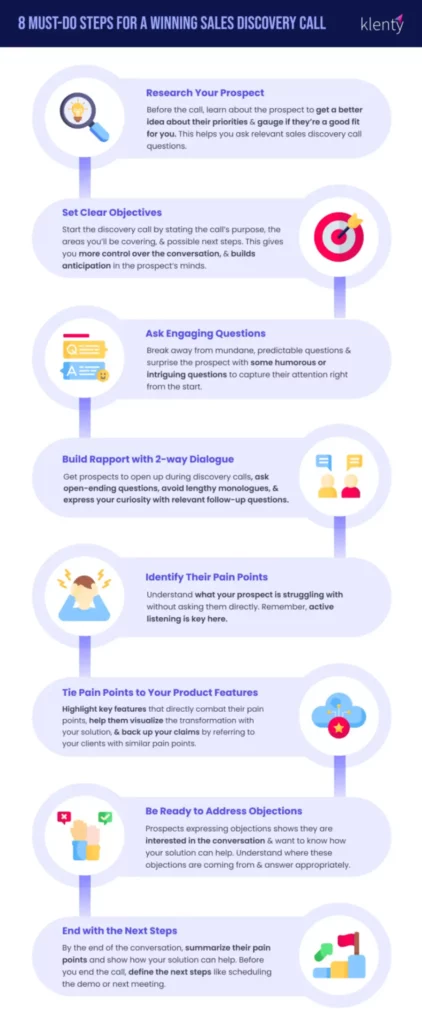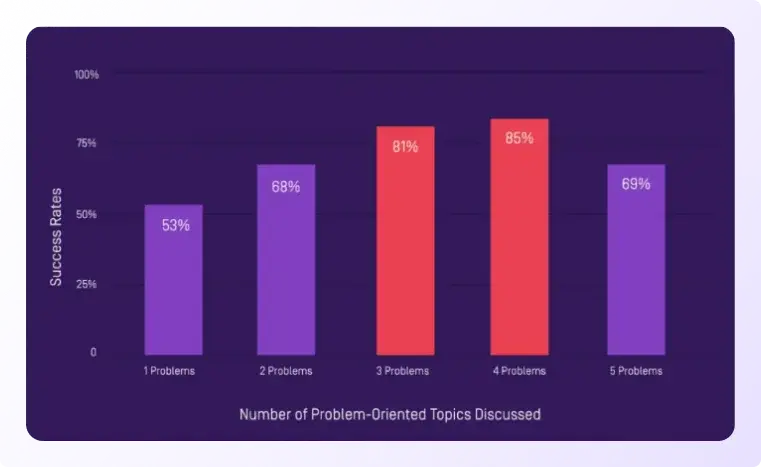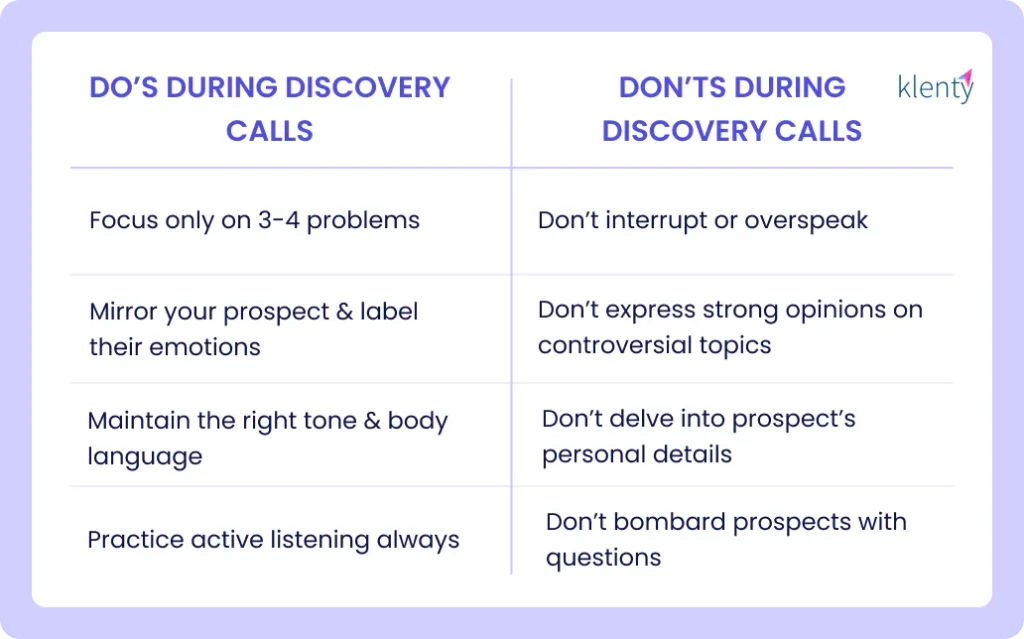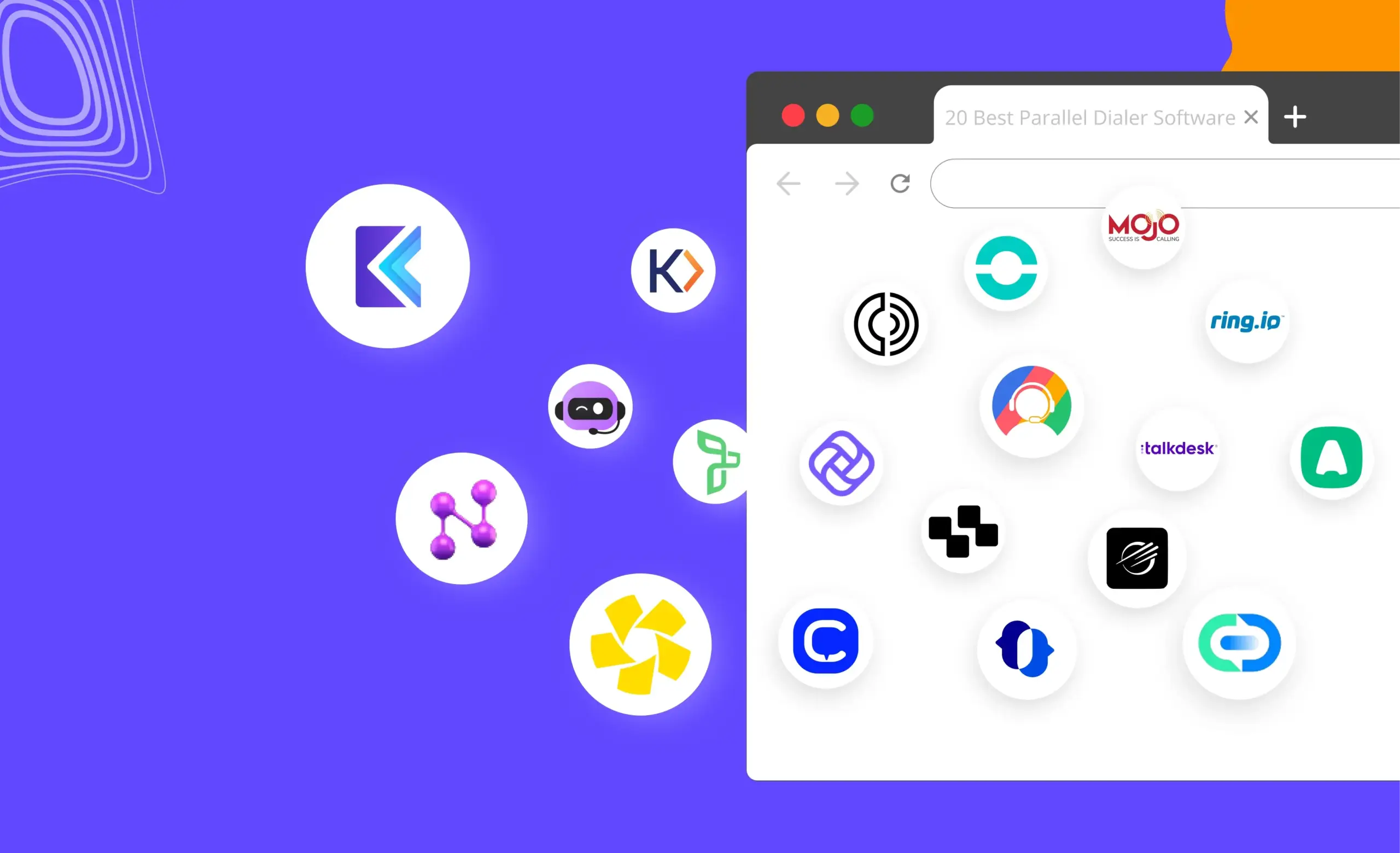Congrats! You've conquered the first huddle and scored a meeting with your lead with your sales pitch.
What's next? How do you add them to your sales pipeline?
It's time to gear up for the discovery call.
It's the first and most crucial step of the sales process. But mind you—it's not your average sales pitch, nor is it a typical interview. So what is a discovery call all about, and how do you navigate it like a pro to seal the deal?
In the SaaS world, where prospects have a plethora of options to choose from, a good discovery call can help them find the right solution, and help salespeople set the course for long-lasting relationships with prospects.
In this article, we’ll dive into how you can conduct an effective discovery call, the key components of a great discovery call, the right questions that should anchor it, and what the right set of activities is to do – before and after the call.
What Is a Discovery Call?
A discovery call is a sales call that happens after a prospect books a meeting with you and before you show them your sales demo. The call lets you discover your prospect’s needs and challenges better after they have shown an initial interest in your solution and helps you present a demo that caters to their requirements better.
Discovery call is perhaps the most important conversation a salesperson has with a prospect. It forms the foundation of the rest of the sales journey.
During a discovery call, you should focus on finding the prospect’s pain points, goals, hopes, fears, and operating boundaries – to assess if your product can help them succeed. By running a good discovery call, you avoid wasting your prospect’s (and your) time with a low-value sales pitch.
“If you jump on a Zoom and just start pitching, you’re almost never going to close the deal. I’ve seen this first-hand where companies just start prattling on about all of their products and features, having no clue what’s important to me. That sucks. As the seller, you need to match your features and benefits to the specific challenges your prospects face.” —Justin Welsh, JW Strategic Advisory
How Is a Discovery Call Different From a Lead Qualification?
While both lead qualification and discovery call are essential elements of the sales process, they serve very different purposes. Lead qualification is when a sales rep assesses potential clients to determine if they're a good fit for their solution. This qualification process involves using methods like:
- BANT (budget, authority, needs, time)
- MEDDIC (metrics, economic buyer, decision criteria, decision process, identify pain, champion)
- ANUM (authority, need, urgency, money)
- GPCTBA/C&I (goals, plans, challenges, timeline, budget, authority, negative consequences, positive implications)
- CHAMP (challenges, authority, money, prioritization)
A discovery call is a more in-depth conversation with a prospect after you've qualified them as a suitable lead.
The ultimate objective of discovery calls is qualifying whether a lead is worth your time. Good delivery questions for sales help you learn:
- Who the prospects are, what they need, and what they prioritize as a company
- How their teams are structured
- What do their buying process and workflows look like
- Who within their organization would (and could) use your product
- How the organization is funded, or what its revenue model looks like
- What are their short and long-term plans are
What's the Purpose of a Discovery Call?
1. Builds Healthier Customer Relationships
Whether an outbound or inbound lead, the discovery call is most likely one of your customer’s first real interactions with the people behind your brand. So, it’s your best shot at making a great first impression and charting the course of the sale. How do you pull this off? By engaging in meaningful conversations, digging deep into the prospect's needs, and establishing credibility by showing you're genuinely interested in their success.
The better you understand your lead, and the more you impress them, the easier it will be for you to find the right track for them and set the tone for a smooth sales journey.
2. Improve Your Sales Process
A discovery call in SaaS is your best chance at finding out how serious the buyer is about your solution, if they’re looking for something specific, and how you could turn the deal in your favor to accelerate your sales cycle.
This is your best chance to:
- Understand the prospect’s team, its structure, the decision-makers,
- Gauge their budget,
- Assess the current and expansion potential of their deal.
If you do this at the earlier stages of the sale, you can avoid situations where a prospect throws an impossible-to-overcome objection in your face at the far end of the sale. It’s a classic prevention-is-better-than-cure scenario.
3. Shortens Your Sales Cycle
Good discovery calls help you focus on what matters. They help you identify the right prospects who are more likely to convert into customers. It works both ways: the sooner you disqualify your leads, the more time you save to focus on other leads. And if your leads are better qualified, you can allocate more time to them based on how likely they are to convert or how big the deal is. As a result, you spend way less time and resources on a prospect, handling more leads and closing deals faster.
8 Steps for Running a Successful Discovery Call
A discovery call is the first step to converting a potential lead into a customer. Therefore, you need a solid sales call plan to learn all the important details about them and move them further along the sales pipeline. Here's what the discovery process looks like:

1. Research Your Prospect
The idea is simple—gathering all important information about the prospect before the discovery call to make the discovery process as valuable as possible to you and the prospect. This fulfills two purposes:
- You get a better idea about their goals and priorities to ask relevant sales discovery call questions. This way, you can show the prospect you've done your homework and avoid asking questions for information that is readily available online.
- You can gauge if the prospect is a good fit for your business. Look out for any red flags that make them an unqualified lead and drop them from the sales pipeline to focus on other high-quality leads.
So, what exactly should you look for? Clari Copilot’s Akshaya Sampath follows a simple pre-call research strategy based on whether the lead is outbound or inbound.
For outbound leads, she tries to learn:
- Why did they get on a call with her?
- What did the SDR of her company note down about them?
- Why is she targeting their company?
For inbound leads, she digs into the following details:
- Which marketing campaign generated this lead?
- How did her solution solve their pain points for customers?
- Which industry does the prospect’s company fall under?
Don't stress if you can't track down all the nitty-gritty details about the prospect. You are preparing for a "discovery" call, after all. But try to dig up as much information as possible so you don't have to wing your way through the conversation.
2. Set Clear Objectives
Don't fire away your list of questions as soon as the prospect answers the call. You're trying to learn more about them, not interrogate them. Start by setting the agenda for the call. This gives you more control over the conversation and sets the right expectations for the prospect.
Before asking the questions, Pleo's Jan Benedikt Mundorf usually lays down the agenda by summarizing how each of the processes—discovery, demo, and negotiation—will look like. It builds anticipation in the prospect's mind, making them eager to continue the conversation.
For example, you can say something like: “The purpose of this call is to learn more about your goals and pain points. If, by the end, we feel that our solution aligns well with your needs, I'll be happy to schedule a follow-up with my sales team to explore the next steps.”
3. Ask Engaging Questions
Instead of using drab, routing queries that feel like an interview, inject some humor into your questions. This makes the conversation more interactive and enjoyable. The idea is to break away from mundane, predictable inquiries and surprise the prospect with intriguing and entertaining questions.
How does this benefit you? By
- Capturing the prospect's attention right from the start.
- Encouraging them to participate actively.
- Differentiating you from competitors.
- Building a positive rapport.
Which brings us to our next point.
4. Build Rapport With Two-Way Dialogue
Listen as much as you talk. But don't steal the show. Let the prospect do most of the talking. Top-performing reps have a talk-to-listen ratio of 46:54 during discovery calls—they listen more to their prospects than talking.
This makes the prospect feel heard, and they are more likely to open up. Plus, it allows you to showcase your expertise while understanding the prospect's needs without stepping on their toes.
You can do this in 3 simple ways:
- By asking open-ended questions and listening actively to their responses.
- By avoiding lengthy monologues that can dominate the conversation.
- By showing your curiosity and asking relevant follow-up questions.
You can also look into the prospect's personal and professional life to draw relevant connections. But don't overdo it. "I don't like to get too professional. I also don't like to get too personal. So I'll go either way, but I won't cross any lines," says Klue's Qayam Noorani. He’d keep his conversation restricted to any of these 4 things about the prospect, which he finds out in his research:
- What other companies have they worked for before?
- Where are they based?
- Who else do they know in his network?
- Any recent trigger events at their company? (product launch, acquisitions, etc.)
5. Identify Their Pain Points
This is the crown jewel of your discovery call—the ultimate objective. It helps you understand what your prospect is struggling with and if your solution is the holy grail they've been looking for.
But this is easier said than done. You can't just ask them about their pain points directly. It's also possible that the prospect might not have recognized the pain point. Therefore, you must be slick and ask all the good sales discovery questions to prod them into sharing the relevant details.
Remember, active listening is key here. You are discovering the prospect, not the other way around.
6. Tie Their Pain Points to Your Product Features
Your prospect's pain points are like a city under attack. And with all your clever questions, you've figured your solution is the superhero that can swoop in to save the day. The next step? Show them how all of their pain points can find their perfect match in your product's incredible features. How?
- Highlight key features that directly combat their pain points.
- Help them visualize the transformation with your solution.
- Back up your claims by referring to your clients with similar pain points.
But remember, this is a discovery call. Not a sales pitch. So don't go ham singing praises of your product. Keep it subtle and focused on the prospect's pain points.
7. Be Ready To Address Objections
Let's quickly circle back to the 4th step—focusing on two-way dialogue. This helps you understand the prospect's sales objections and answer them appropriately to win them over.
And objections aren't a bad thing. It shows the prospect is interested in the conversation and open to understanding how your solution can help.
Plus, these questions can reveal a lot more about their pain points and buying intent. For example,
- If they're asking discovery questions for customer service or the pricing structure, they may be further along the sales process than you anticipated.
- If they're asking questions about a particular product feature, it might be their area of concern.
By understanding where these questions are stemming from, you can gain a deeper understanding of their priorities and preferences.
8. End With the Next Steps
By the end of the conversation, you will have an idea of whether or not to take the lead forward. If the prospect is a good fit, summarize their pain points and show how your solution can help.
And don't keep them hanging. Schedule the next steps before you disconnect the call. This can be:
- Scheduling a product demo.
- Booking a second meeting with the prospect to break down technical aspects.
- Booking a meeting with another stakeholder from the prospect's company.
This helps you keep them moving through the sales pipeline.
10 Discovery Call Questions You Should Ask Prospects
A good discovery call relies on carefully selected questions to get the most out of the discovery call. Analysis of discovery calls has shown that successful discovery calls typically use 11-14 questions.
PRO TIP: To get the most out of your questions, you can also use the TED questioning model, which works great with probing questions. This allows for open-ended questions that give you more insight into their needs.
T: Tell me more about…
E: Can you please explain …?
D: Could you describe how …?
Here are the 10 best discovery call questions sourced from top-performing account executives. Use these at different points of your sales call to get the desired response from your prospects.
Questions for Qualification
Questions about the company’s goals, the team’s priorities, individual KPIs, the team’s structure, etc. let you in on their business so you get an inside-out view of what matters. Qualifying pre-sales delivery questions will help you decide how serious they are about a purchase. But such information will come in handy at later stages of the buyer’s journey, as well, when you need to persuade multiple stakeholders.
For instance, knowing how their KPIs connect to the organization’s goals can help you assess how invested they would be in pushing for and using your product.
Understanding the structure and plans of the prospect’s team can help you understand how much ROI you can unlock for them and yourself.
For example, if they came in to buy 2 seats for your product, but your questioning revealed that they are a 20-member team—you know that you have a great shot at getting the rest of the team on the software as additional users.
Here are examples of some questions you could ask (Feel free to give them your own twist):
- What are the main goals of your company?
- What are the main reasons for considering {solution} at this stage?
- Who on the team would use the tool?
Questions for Deep Discovery
Once you get a big-picture view of their long-term goals, you can paint a picture of how your product/service can help them get there to the end goal. But this depends on asking deeper discovery call questions to find how they intend to get there, what roadblocks they face, and what solutions they are expecting. Here are some of the questions you can ask at this stage:
- What is your current {workflow and tools used for the process}?
- Why do you feel the need to change your existing solution?
Questions for Consultative Discussions
These questions focus on guiding the prospect toward considering your solution as the best fit for their needs. They help you position yourself as a trusted advisor and build credibility.
- Have you tried solving {pain point} in the past? If yes, could you talk about your past attempts and how successful they were?
- How would a successful implementation of our solution impact your team's productivity or efficiency?
PRO TIP: Use social proof stories as part of your questions. Discovery calls with the most positive prospect sentiments are found to include an average of two stories. Use your experience with other customers to say “When we worked with one of our customers on their SEO project, we saw that they struggled to keep their sitemaps updated. Is this something your team struggles with? What has your experience with working with your developers to fix such issues been like?”
Questions To Understand Decision-Making
Here are some of the questions you can use to understand the prospect’s decision-making process:
- What does your decision-making process look like from here?
- What boxes do you need to be checked off before moving forward with us?
- Are you evaluating somebody with us at this point in time?
Looking for more? We've compiled 25+ discovery call questions in the above categories that you can use in your sales discovery process. Grab the full list of discovery call questions for free here and find success in your sales discovery every time!
4 Best Practices for SaaS Discovery Calls
So you've researched your prospect and made a note of all the important questions you're going to ask? Before you jump on the call in hopes of acing it, you need to be aware of best practices that’d ensure your prospect is not only engaged but also impressed.
Here are 4 best practices that will make your discovery calls shine:
1. Focus On 3-4 Problems
Gong’s findings from its analysis of 1000s of B2B sales discovery calls have shown that successful sales teams uncover only 3-4 customer problems.
One possible reason why this works, according to the analysis, is that if you focus on more than 4 problems, there would be too many priorities to focus on for both you and your prospect. And less than 3 problems means there aren't enough pain points for your solution to solve.

(Source: Gong)
2. Mirror Your Prospect and Label Their Emotions
Chris Voss, author of the book Never Split the Difference, says mirroring is most effective when you repeat one to three words from the last words your counterpart has spoken. In the discovery call, use your customer’s language and say your prospect’s last 2-4 words back to them as a question.
He also recommends using phrases like “It sounds like you…”, “It seems like you…”, or “I can see why that’s frustrating…” to label their emotions. This way, you develop a stronger connection grounded in understanding and empathy.
3. Focus on the Right Tone and Body Language
In a discovery call, what you say is just as important as how you say it.
The 7-38-55 rule developed by psychology professor Albert Mehrabian at the University of California, Los Angeles, is a concept that focuses on the communication of emotions.
It states 7% percent of meaning is communicated through spoken word, 38% percent through tone of voice, and 55% through body language.
The smaller contribution (7%) of the spoken word goes to show that pauses, silence, and an atmosphere of trust and comfort can go a long way in running better discovery calls.
4. Practice Active Listening
Listen more, talk less. While this applies to the whole sales pipeline, it’s even more important at a stage as critical as discovery.
Studies by RAIN Group show that 68% percent of buyers are highly influenced by sellers who are good listeners. But they also report that only 26% of sellers are good at listening.
According to their founder, John Doerr, sales reps who don’t actively listen lose the opportunity to build rapport and trust, uncover prospects’ needs, and instill confidence in the prospect that the reps understand their world.
What Not To Do on a Discovery Call?
Now that you know what to do on a discovery call, let's focus on the don’ts. There are certain pitfalls that you must avoid at all costs to keep the prospect interested and the conversation flowing smoothly. Let's understand them in detail.

1. Do Not Interrupt or Overspeak
Don't dominate the conversation with excessive talking. Instead, listen actively. Let the prospect share their thoughts and answer your questions without interruptions.
Plus, when you're asking questions or addressing their concerns, avoid over-explaining. Keep your replies to the point and pause for the prospect's response.
2. Do Not Express Strong Opinions on Conversational Topics
Steer clear of controversial topics like politics, religion, or sensitive social issues. It can create a rift between you and the prospect, prompting them to drop the conversation. Remember, the goal of the discovery call is to gather valuable information about the prospect. Not to impose personal viewpoints.
“Never step into a conversation with a preconceived notion, because that not only talks about you but also talks about your brand,” says Paperflite's SMB Sales Head Varshni Gurumoorthy.
3. Do Not Get Too Personal
Always maintain a professional boundary. Delving into personal details can make your prospect feel uncomfortable and avoid engaging in an honest conversation.
To strike the right balance, Localize's Kevin Deldjoui has a thumb rule: "Any conversation that's appropriate for colleagues to have during a water cooler chat holds good during a call as well."
4. Do Not Bombard Your Prospect With Questions
Firstly, this is not an interrogation. Secondly, you'll only end up overwhelming them. Instead, limit your questions to only 3 or 4 to keep the conversation flowing smoothly.
This way, you're giving them the space to share information at their own pace, leading to a more productive conversation.
Discover Your Way to Sales Success
As a salesperson, it’s important to have a balanced attitude about discovery calls. A discovery call is as much about you as it is about the customer. But most importantly, it is about solving a problem.
Dan Smith from Winning By Design perfectly describes this approach to selling: “Don’t try and play mind games on them, don’t ask them backward questions, because, in reality, it’s only salespeople who ask about that. So instead, value their time and the fastest way to do that, show you’ve done your research, show that you know something about them, and you can hopefully help them solve a problem.”
At the end of a good discovery call, your prospect should be able to decide whether to proceed with you or not. But it’s equally important for you to know whether to proceed with them or not. And it paves the way for you to have smoother conversations with them in the later stages of the deal. If you feel your product or service isn’t a good fit, don’t be afraid to cut your losses and end the sales discovery process.
FAQs
1. What Is the Definition of a Discovery Call?
2. How Do You Introduce Yourself in a Discovery Call?
3. What Is the Discovery Call Process?
2. Setting clear objectives
3. Asking engaging questions
4. Building rapport
5. Identifying pain points
6. Connecting pain points to your product features
7. Addressing objections
8. Scheduling the next steps





